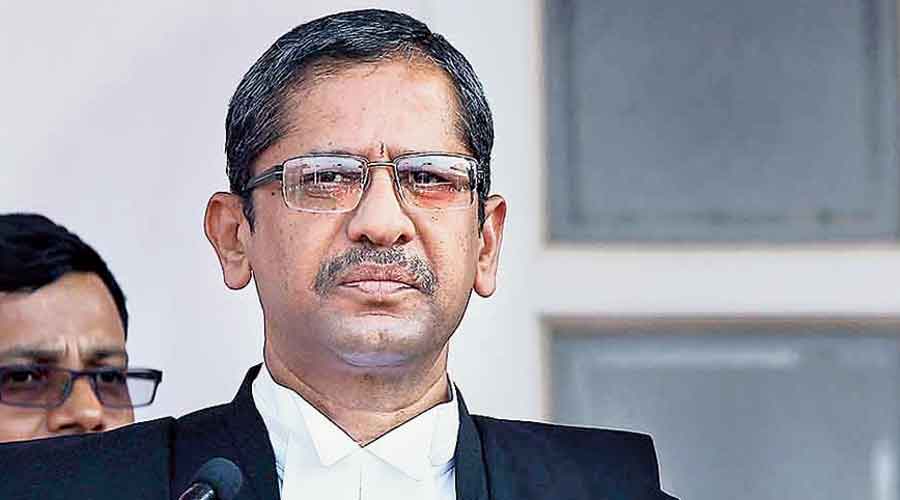Chief Justice of India N.V. Ramana on Saturday expressed concern over lack of adequate representation of women in the judiciary and the trend of “corporatising” the legal profession that has put access to justice beyond the common man’s reach.
Replying to his felicitation by the Bar Council of India, Justice Ramana lamented that the majority of women advocates struggled within the profession and very few found representation at the top.
““Even when they do, they still continue to face significant challenges. After 75 years of Independence, one would expect at least 50 per cent representation for women at all levels, but I must admit (that) with great difficulty we have now achieved a mere 11 per cent representation of women on the bench of the Supreme Court.
“Some states, because of reservation policy, may reveal higher representation, but the reality remains that the legal profession still has to welcome women into its fold,” Justice Ramana said.
The CJI’s remark comes against the backdrop of the elevation of three women judges to the Supreme Court. One of them — Justice B.V. Nagarathna — is in line to become the first woman Chief Justice of India in 2027.
Justice Ramana stressed the need for lawyers to contribute to nation building, but regretted that the profession was being commercialised.
““I want to highlight a new trend in the profession. This is similar to what has happened in foreign countries. I am referring to the corporatisation of the profession. Because of issues relating to livelihood, many young and bright lawyers are joining law firms. This is a welcome change as it is opening up fresh avenues for first-generation lawyers.
“But at the same time, it is also causing a decline in the traditional practice. Common people cannot afford quality legal advice at corporate prices, which is an area of concern. Even though we are strongly providing access to justice, still lakhs of people in India are unable to approach the courts to seek remedy,” CJI Ramana said.
According to him, steep expenditure and long delays in the legal process are the biggest challenges confronting the judiciary and there is a need for all stakeholders to come together to find a way out.
“Although this might not be the right occasion to mention, but as an experienced member of the judicial family, it is my duty to bring to your notice certain hard facts. The judicial system is facing difficult challenges like that of deficient infrastructure, shortage of administrative staff and huge vacancies of judges. I have been emphasising on augmenting infrastructure for very long. I have a proposal to address this issue in a time-bound manner,” the CJI said.
“A comprehensive proposal for the creation of a National Judicial Infrastructure Corporation is under preparation. We have collected the status report from across the country. A proposal in this regard will reach the Hon’ble law minister very soon. I expect full cooperation from the government,” he added.
The CJI referred to Justice B.R. Gavai comparing him with Sachin Tendulkar because the collegium headed by him cleared nine names for elevation as Supreme Court judges at one go last month and then another 68 names on Friday for high courts. Both sets are the highest numbers of names cleared by the collegium in one stroke.
Justice Ramana said: “A while ago I was referred to as Sachin Tendulkar. I must correct the perception here. Like (in) any game, it is a team effort. Unless all the members of the team perform well, it is difficult to win. Here, I must place on record my sincere thanks to my colleagues in the collegium — brothers U.U. Lalit, A.M. Khanwilkar, D.Y. Chandrachud and L. Nageswara Rao — who have become active and constructive partners in this endeavour.
“Due to the collective efforts, as you are all aware, we could reduce the number of vacancies in the apex court to just one. Similarly, after I took over, the collegium has recommended, if I am not wrong, 82 names to various high courts. I hope the government will ensure that the names are cleared at the earliest just the way the nine names were cleared for the apex court.”
It is an ongoing process. We hope to live up to the Herculean challenge of filling nearly 41 per cent vacancies existing in… the high courts.”
Hailing Justice Ramana earlier during the programme, Justice Gavai had described him as “Sachin Tendulkar breaking records one after another”.
Terming the CJI as a “true leader” of the India judiciary, Justice Gavai said: “Under his able leadership, a common man feels that a real judge is there in the Supreme Court… who has a real concern for the common man and the downtrodden.”
Justice Gavai said CJI Ramana treated all other judges as his own brothers and sisters and was always helpful and accessible to them.
Justice Vineet Saran also lavished praise on the CJI, saying Justice Ramana had achieved what is being perceived as an impossible task of clearing the names of nine judges for the Supreme Court and 68 for the high courts at one go.
Justice Saran also reminded the audience of how Justice Ramana had treated as a PIL a letter addressed to him by a 12-year-old schoolgirl, requesting him to resume physical hearings at courts since most other institutions had restarted normal activities.










